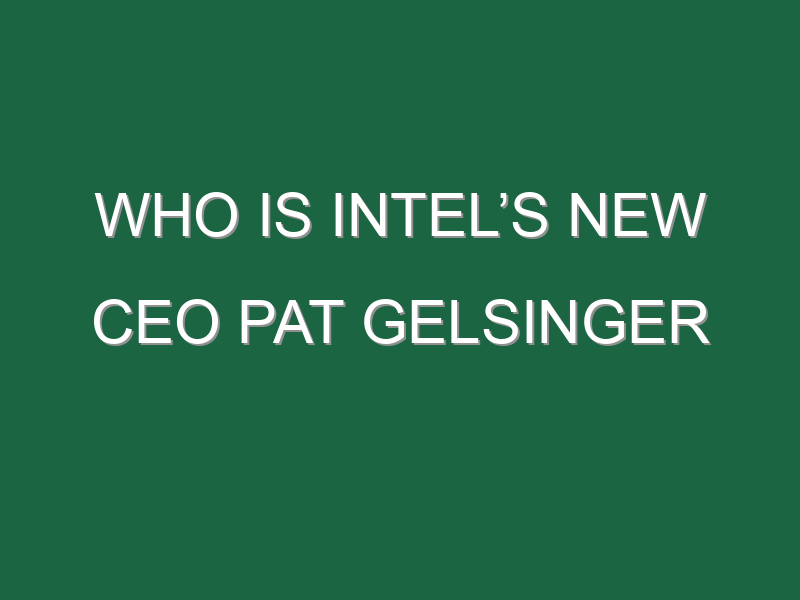Our mission to make business better is fueled by readers like you. To enjoy unlimited access to our journalism, subscribe today.
VMware CEO Pat Gelsinger has always had a reputation as being a bit of a Boy Scout. So he decided to play against type a few years ago for his keynote address at the software company’s annual customer conference in Las Vegas.
“What can I do to take my commitment to the next level,” he asked the crowd. “I went down the street to ‘Bad-Ass Tattoo.’”
Rolling up his sleeve, Gelsinger revealed a huge tattoo spelling out the company’s name in bold black letters across his left forearm. He even had a photo of himself at the aforementioned local parlor getting the seemingly permanent sign of his loyalty to VMware administered by a blonde braided tattoo artist. “Sometimes what happens in Vegas, you take home,” he added.
The audience loved it but his wife was not amused. Luckily for Gelsinger’s marriage, the tattoo was only temporary and the photo was staged.
And now, luckily for his career choices, too. Intel announced on Jan. 13 that its current CEO, Bob Swan, was stepping aside next month and that Gelsinger would take over. In many ways, it’s a return of the prodigal son, as Gelsinger, 59, spent three decades at Intel before leaving in 2009 for EMC and eventually the top role at VMware.
Intel could use some help. The once-dominant chipmaker for PCs and servers is facing challenges from all directions. While manufacturing stumbles have hamstrung Intel’s own chip improvements, Advanced Micro Devices is grabbing market share with better performing processors. Nvidia is buying rival Arm to bolster its position in processor chips and Apple has defected from Intel to chips of its own designs, perhaps enticing Microsoft to follow suit. Meanwhile, big cloud services at Amazon and Google are developing their own server chips to displace Intel as well.
A lot of Intel’s shortcomings over the next three years “are likely already set in stone, and there is not much Pat is going to be able to do to change that,” longtime chip industry analyst Stacy Rasgon at Bernstein Research noted after the announcement on Wednesday.
Gelsinger certainly seems up to task. Growing up on a farm in a rural Amish part of Pennsylvania, he woke up before dawn to care for pigs and cows. His main morning task, he told Forbes years later was to “go straight to a day of dusty labor and try not to get kicked by an animal.”
Neither of his parents had more than an eighth-grade education, he told the Computer History Museum. “They just pounded into us, from early ages, go to school, go to school,” he said.
In high school, he showed an aptitude for math and science and graduated early after winning a scholarship at a branch of the Lincoln Technical Institute. That was the first place he encountered computers, excelled at electronics, and drew the attention of a recruiter from Intel. A job interview in Silicon Valley came courtesy of the first plane ride of his life. Only 18 years-old and without a four-year college degree, Gelsinger took a job at Intel as a quality-control technician in 1979.
Taking advantage of Intel’s generous tuition reimbursement program and flexible work hours policy, he then got a BA in electrical engineering at Santa Clara University in 1983 and a Master’s degree from Stanford University in 1985, all while working full-time. Legendary computer science professor John Hennessy was Gelsinger’s master’s advisor at Stanford.
He also continued gaining responsibilities. While working on Intel’s 386 processor, he drew the attention of hard-driving Intel CEO Andy Grove, a “career defining moment,” Gelsinger said later. Grove mentored Gelsinger for decades afterwards.
Gelsinger was put in charge of the design of Intel’s popular 486 chip line in his 20s and became the company’s first ever chief technology officer in 2001, at age 40.
Gelsinger has a somewhat unusual background in Silicon Valley as a devout Christian. A strong religious upbringing has helped navigate the difficulties of the corporate world, he says. A favorite biblical version from the Book of Colossians commands, “Whatever you do, work at it with all your heart, as working for the Lord, not for human masters.” He cited the verse in a 2016 interview, adding: “I can get the snot kicked out of me at a board meeting or during a sales call, and I can rebound the next day, full of joy and purpose, to start anew.”
He also met his wife Linda at church services when he first moved to California.
Despite all his success and talents at Intel, Gelsinger was passed over for the top job in 2005, when Paul Otellini was selected. Gelsinger hopped to data storage giant EMC as chief operating officer in 2009, moving to the Boston area.
Still aiming to be a CEO, he asked to attend EMC board meetings and got plenty of advice from the company’s co-founder, Jack Egan. “We’re an East coast company. You need to dress like you’re at an East coast company,” Egan told him, Gelsinger later recalled. The command prompted a quick shipping trip to Nordstrom’s that night.
Egan also told Gelsinger he needed to better understand corporate finance. So Gelsinger spent a year getting tutored by a Columbia University professor in the subject.
The homework paid off when the top job at EMC’s VMware unit opened up in 2012.
At first, the fight was against cloud computing. Amazon advocated that companies give up running their own data centers and move to the cloud. Gelsinger tried to fight back with offerings to make data centers more efficient and more secure. Then VMware tried to create its own cloud service, but that flopped. Ultimately, opposing the cloud was a losing battle and Gelsinger shifted strategy completely, partnering VMware with Amazon and Microsoft’s services and making software that assisted customers moving to the cloud.
“Simply put, customers are asking us to do more together,” Gelsinger told Fortune in August 2019 explaining the deal with Microsoft Azure. He further outlined his philosophy in another interview with Fortune in April 2019. “If you don’t get in front of these waves of transition, you’re driftwood,” Gelsinger said. “You’ve got to get on the right portion of the wave and have that energy pull you forward.”
The deep engineering background has helped Gelsinger identify trends like the cloud, which should help him steer the ship at Intel. A few years ago, he even coined an acronym for what he saw as the most important trends of the time, though it was an acronym only an engineer could love: SOMOCLOBAT. That stood for social, mobile, cloud, and big data.
Intel has struggled in several of those areas, particularly mobile. Gelsinger will need more than a few more acronyms to succeed.
More must-read tech coverage from Fortune:
- PC sales have surged for at-home workers and learners during the pandemic
- Commentary: Tech’s underdeveloped moral compass is threatening our democracy
- Verizon to expand fast 5G to NFL stadiums, music venues, and UPS delivery drones
- IBM received the most patents in 2020. Here’s the rest of the top 20
- Chip Wars 2021: What AMD, Intel, and Nvidia announced at CES





